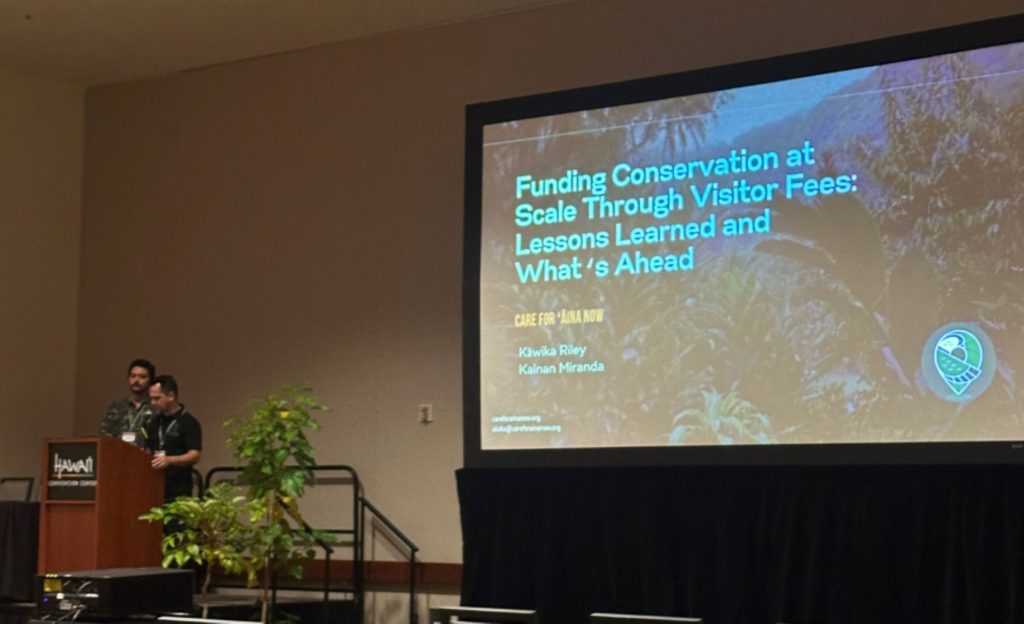Care for ʻĀina Now coalition encourages public to weigh in on new ‘Green Fee’
Care for ʻĀina Now hosted its 32nd Hawaiʻi Conservation Conference last week, bringing together more than 1,300 scientists, policymakers, conservation practitioners, educators, students and community members from throughout Hawaiʻi and the Pacific region.
The coalition presented about how implementing the state’s new “Green Fee” law can work and the critical shortfalls Hawai‘i’s natural resources are currently facing.
Presenters also announced a survey they hope everyone will complete by Aug. 15 to weigh in on the new fee.

Hawai‘i Gov. Josh Green at the end of May signed Hawai‘i Senate Bill 1396 into law, enacting Act 96 and creating the first climate impact fee, or “Green Fee,” in the nation.
The new fee — an increase from 10.25% to 11% in the state transient accommodations tax — provides a stable source of funding for environmental stewardship, hazard mitigation and sustainable tourism and projected to generate about $100 million annually.
To put it in perspective: a $400 hotel room will incur an additional $3 per night in taxes.
“Once again, Hawaiʻi is at the forefront of protecting our natural resources, recognizing their fundamental role in sustaining the ecological, cultural and economic health of Hawaiʻi,” Green said in a release following his May 27 signing of Act 96. “As an island chain, Hawaiʻi cannot wait for the next disaster to hit before taking action. We must build resiliency now, and the ‘Green Fee’ will provide the necessary financing to ensure resources are available for our future.”
Hawaiʻi Conservation Alliance Foundation Executive Director Ulu Ching said the Hawaiʻi Conservation Conference brings together the diverse conservation narratives that describe the current state of Hawaiʻi’s precious native and natural ecosystems to drive action and inspire future generations.
The foundation is a member of the Care for ʻĀina Now coalition. Ching added the conference provided a space to celebrate innovations, identify new areas of intersection and for members to provision themselves for the voyage ahead.
“Our community of conservation practitioners held space together and were comforted, rejuvenated and activated after a painful period of disruption and loss,” Ching said in a release from the coalition. “Now is the time to accelerate our efforts, to be fearless and double down on ideas previously thought unfathomable.”
Many from organizations such as Hawaiʻi Conservation Alliance Foundation are excited to see the designated “Green Fee” support critical work caring for ecosystems that help keep communities safe from wildfires and flooding.
Care for ʻĀina Now encourages the public to complete the survey, which was created to gather descriptions of funding needs.
Information could be shared on a preliminary and/or summary basis with governmental organizations planning legislative funding requests, but this is neither a request for proposals nor an assurance any funding will be provided.
It also is not a pathway to funding or affiliated with the governorʻs office, but will be a resource for the coalition’s leadership as it shapes recommendations for funding implementation.
Click here and take the survey.
“The ‘Green Fee’ bill marks a historic investment in climate disaster resilience and environmental protection,” said Hawaiʻi Climate Advisory Team Chairman Chris Benjamin in the governor’s office release following Green’s signing of Act 96. “Using the [transient accommodations tax] to fund resiliency projects ensures that the financial burden of safeguarding our ʻāina and people doesn’t fall upon residents alone.”
Visit the Care for ʻĀina Now website and follow the coalition on social media @careforainanow for additional information.



